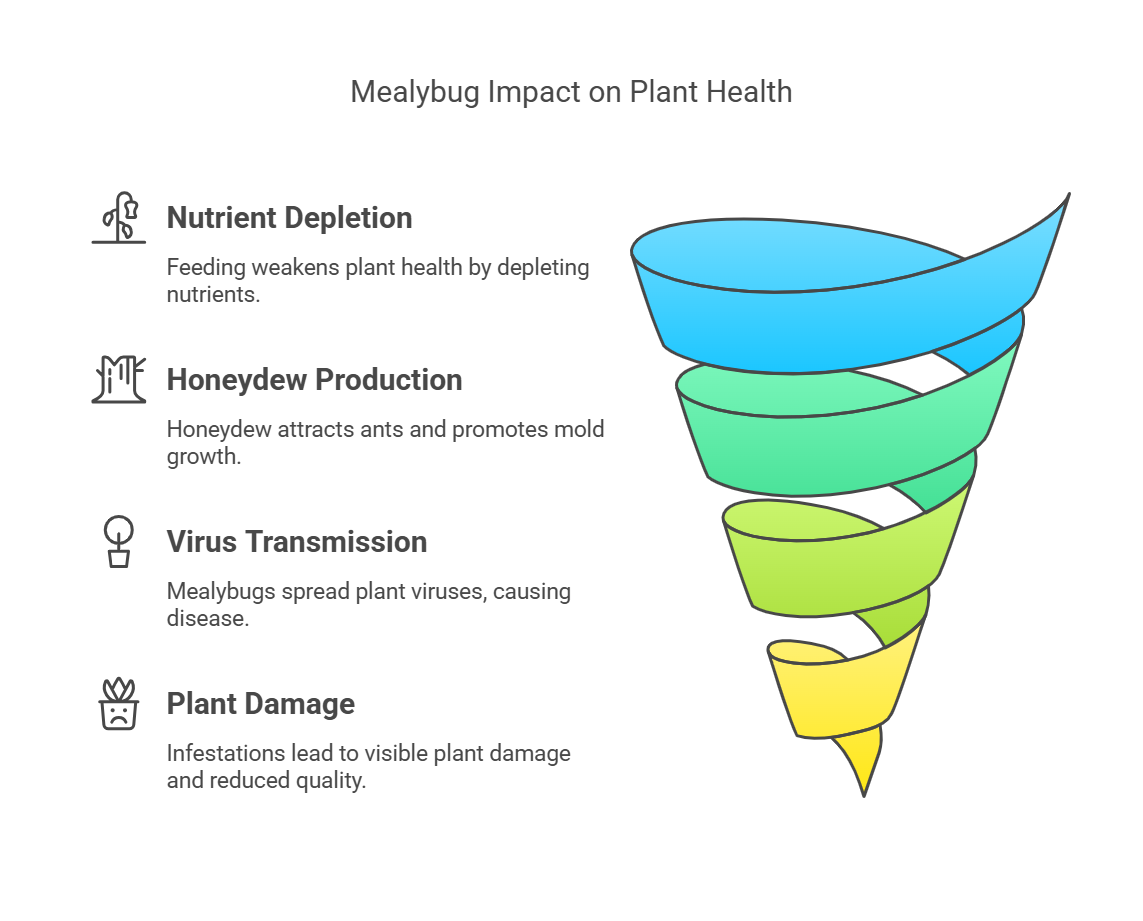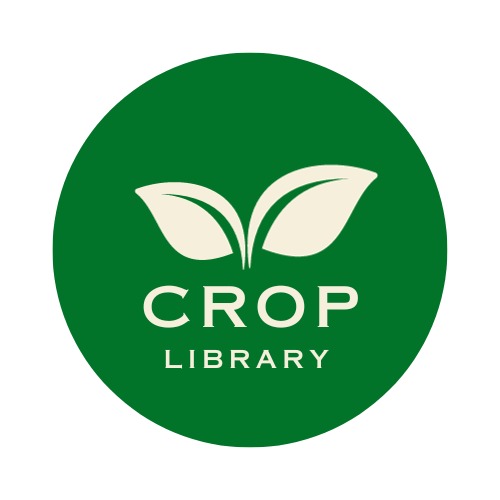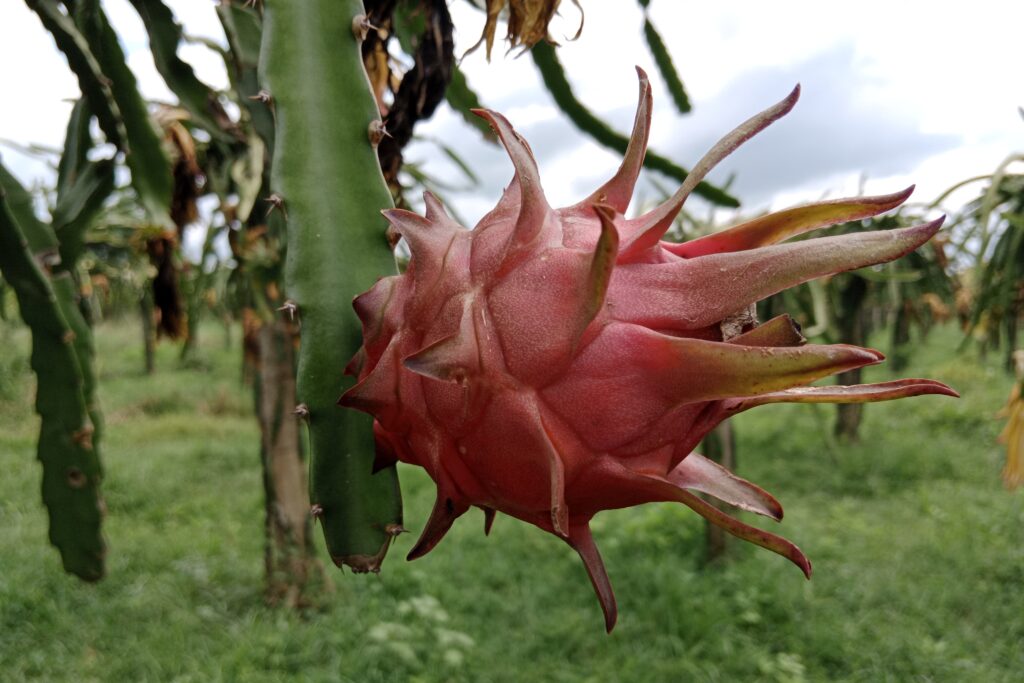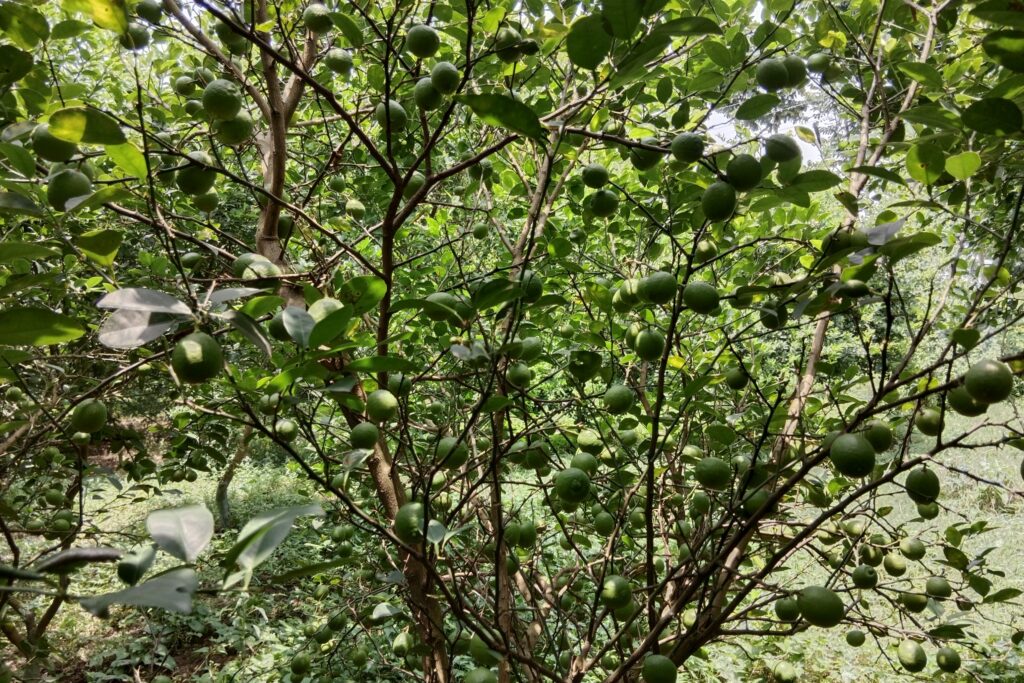Mealybugs
Mealybugs, belonging to the family Pseudococcidae, are small, soft-bodied, sap-sucking insects that pose significant threats to agricultural and horticultural ecosystems. These pests are commonly found on a wide variety of host plants, including trees, ornamental plants, and greenhouse crops. Their ability to extract plant sap using specialized mouthparts not only weakens their host plants but also leads to the secretion of honeydew, a sugary substance that promotes the growth of sooty mold and attracts protective ants.
Furthermore, some mealybug species serve as vectors for plant viruses, exacerbating the damage they cause. The combined effects of nutrient depletion, mold formation, and disease transmission often result in stunted plant growth, leaf yellowing, deformation, and reduced crop yields. These destructive traits make mealybugs one of the most economically impactful pests, requiring diligent management strategies to minimize losses in agriculture and horticulture.
Morphological Characteristics
Body Structure
Female mealybugs are small insects with an oval, soft-bodied, and flat appearance, typically measuring only a few millimeters in length. Their compact size and flexible structure allow them to adapt easily to various surfaces on their host plants.
A notable feature of female mealybugs is their segmented bodies, which provide enhanced mobility and flexibility. This segmentation enables them to move efficiently in search of feeding sites, making them more adaptable and resilient pests.
Additionally, female mealybugs are often covered in a flocculent, cottony, or mealy wax secretion. This waxy layer serves as a protective barrier, helping to reduce water loss through desiccation and providing defense against predators. This adaptation plays a crucial role in their survival in diverse environmental conditions.
Wax and Secretions
Mealybugs possess specialized glands called ostioles, which secrete sticky substances that contribute to honeydew production. This honeydew attracts ants and promotes the growth of sooty mold, further impacting plant health.
Leg Development
Unlike many scale insects, female mealybugs have well-developed legs, allowing them to move easily in search of suitable feeding sites.
Male Rarity
Male mealybugs are rare or entirely absent in many species, as reproduction often occurs through parthenogenesis, a form of asexual reproduction. When males are present, they are winged and short-lived, with their sole purpose being to fertilize females before dying.
Also Read About: San Jose Scale Insect
Feeding Behavior and Impact on Plants
Phloem Feeders
Mealybugs are phloem feeders that use their needle-like mouthparts, known as stylets, to extract sap from host plants. This feeding behavior depletes the plant’s nutrients, weakening its overall health and vigor.

Honeydew Production
Mealybugs produce honeydew as a byproduct of their sap-feeding, which attracts ants and creates a favorable environment for sooty mold growth. The sooty mold forms a dark, sticky layer on plant surfaces, blocking sunlight, reducing photosynthesis, and significantly diminishing the aesthetic value of ornamental plants.
Virus Transmission
Some species act as vectors of plant viruses, spreading diseases among crops and greenhouse plants.
Plant Damage Symptoms
Mealybug infestations cause a range of plant damage symptoms, including yellowing and curling of leaves due to sap depletion. Affected plants often exhibit stunted growth and deformities in young shoots and flowers. In crops like citrus, mealybug feeding can lead to premature fruit drop and a noticeable reduction in fruit quality, resulting in significant economic losses.
Major Mealybug Pests and Their Hosts
Apple Mealybug (Phenacoccus aceris)
The Apple Mealybug (Phenacoccus aceris) is a significant pest that primarily affects apple trees, as well as beech trees and various other deciduous hosts, particularly in Central Europe. These pests infest the bark, young shoots, and leaves, extracting plant sap and weakening the overall health of the tree. Infestations can lead to stunted growth, leaf yellowing, and premature leaf drop, ultimately reducing fruit yield and quality. Severe infestations may also create a favorable environment for sooty mold development, further impacting the tree’s photosynthetic ability. Effective pest management strategies, including biological control and the use of horticultural oils, are essential to minimize economic losses caused by the apple mealybug.
Woolly Beech Aphid (Phyllaphis fagi)
The Woolly Beech Aphid (Phyllaphis fagi), though not a true mealybug, is often mistaken for one due to its characteristic woolly secretions. This pest is commonly found in temperate regions, where it primarily infests beech trees. The aphids feed on the sap of young leaves, leading to noticeable leaf curling and distortion. Severe infestations can weaken the tree, reducing its overall vigor and making it more susceptible to secondary infections. In addition, the honeydew excreted by these aphids promotes the growth of sooty mold, further affecting the tree’s health. Effective management includes promoting natural predators, such as ladybugs and lacewings, along with targeted horticultural treatments.
Citrus Mealybug (Planococcus citri)
The Citrus Mealybug (Planococcus citri) is a significant pest that affects citrus trees and various greenhouse crops, including tomatoes and peppers. This pest feeds on plant sap, weakening the host and leading to stunted growth. Infestations result in blemished fruit, reduced market value, and, in severe cases, premature fruit drop. Additionally, the honeydew secreted by the mealybugs encourages the growth of sooty mold, further deteriorating fruit quality. Effective management strategies include the use of biological control agents, such as predatory beetles and parasitic wasps, as well as careful monitoring and the application of horticultural oils or insecticides when necessary.
Glasshouse Mealybug (Pseudococcus viburni)
The Glasshouse Mealybug (Pseudococcus viburni) is a common pest that primarily infests greenhouse ornamentals, fruit crops, and nursery plants. It feeds on plant sap, causing a decline in plant vigor, stunted growth, and leaf distortion. The pest secretes honeydew, which promotes the growth of sooty mold, further diminishing the plant’s aesthetic and commercial value. Severe infestations can weaken plants, making them more susceptible to other pests and diseases. Effective management strategies include biological control using natural predators, regular monitoring, and the application of horticultural oils or insecticidal soaps to minimize infestations.
Mealybug Management and Control Strategies
Cultural Control
- Regular Plant Inspections: Early detection of white cottony masses helps prevent outbreaks.
- Sanitation and Pruning: Remove infested plant parts and dispose of debris to limit spread.
- Ant Control: Manage ant populations, as ants protect mealybugs in exchange for honeydew.
Biological Control
- Natural Predators: Lady beetles (Cryptolaemus montrouzieri), lacewing larvae, and hoverfly larvae feed on mealybugs.
- Parasitic Wasps: Encyrtid wasps (Anagyrus pseudococci) parasitize mealybugs, reducing populations.
Chemical Control
- Insecticidal Soaps and Horticultural Oils: Effective in breaking down waxy coatings and suffocating mealybugs.
- Systemic Insecticides: Products like imidacloprid and thiamethoxam are useful for severe infestations.
- Timing of Treatment: Sprays are most effective against crawler-stage nymphs.
Conclusion
Mealybugs (Pseudococcidae) are widespread, polyphagous pests causing damage to fruit trees, ornamentals, and greenhouse crops by sucking sap, excreting honeydew, and transmitting viruses. Their waxy coating and hidden feeding habits make control challenging. However, integrated pest management (IPM) strategies combining biological control, cultural practices, and targeted insecticides can effectively suppress their populations, minimizing agricultural and horticultural economic losses.



Pingback: Understanding Auchenorrhyncha: From Morphology to Pest Management -